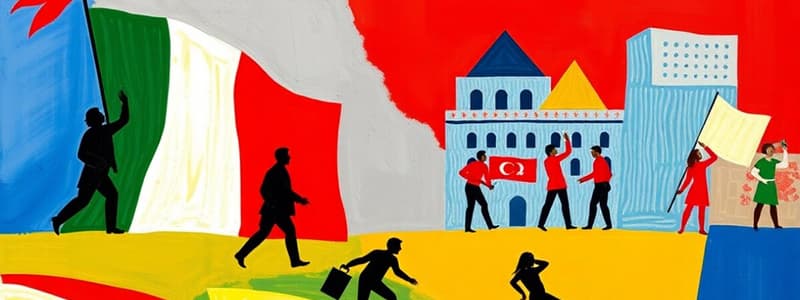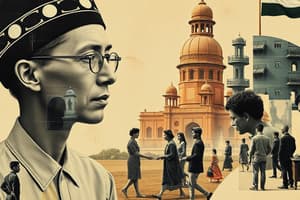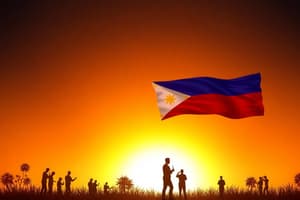Podcast
Questions and Answers
What did Napoleon do to help build a French national identity?
What did Napoleon do to help build a French national identity?
- He used newspapers and media to promote a sense of national unity.
- He emphasized the idea of deriving government legitimacy from the people.
- He mandated French literacy and national pride through education.
- He centralized the army and instilled patriotism. (correct)
How did industrialization contribute to the creation of a unified French identity?
How did industrialization contribute to the creation of a unified French identity?
- It increased the demand for skilled labor, leading to widespread education and workforce training.
- It created a national school system that taught the French language and fostered a sense of national pride. (correct)
- It encouraged the migration of people from rural areas to urban centers, leading to cultural homogenization.
- It led to a rise in religious devotion and a shared religious identity.
What is a key characteristic of the concept of a nation?
What is a key characteristic of the concept of a nation?
- Shared genetic heritage.
- A unified religious identity.
- A long history of shared cultural practices and traditions.
- A common language and shared cultural attributes. (correct)
What does the text suggest is the primary reason nations are not natural entities?
What does the text suggest is the primary reason nations are not natural entities?
What is the primary similarity between Napoleon and leaders who fabricated national mythologies?
What is the primary similarity between Napoleon and leaders who fabricated national mythologies?
Which of the following is a key consequence of the rise of nations?
Which of the following is a key consequence of the rise of nations?
Why did nations like Italy struggle to create a shared national identity even after unification?
Why did nations like Italy struggle to create a shared national identity even after unification?
What is a potential danger associated with national identities?
What is a potential danger associated with national identities?
What is a key takeaway about the invention of nations?
What is a key takeaway about the invention of nations?
Why are the borders of modern nations not always reflective of the actual distribution of ethnic groups?
Why are the borders of modern nations not always reflective of the actual distribution of ethnic groups?
What is a key characteristic of modern nations, according to the content?
What is a key characteristic of modern nations, according to the content?
What is a central argument about nations presented in the content?
What is a central argument about nations presented in the content?
Which of the following is NOT mentioned as a factor contributing to the rise of “supra-national identities” like “European”?
Which of the following is NOT mentioned as a factor contributing to the rise of “supra-national identities” like “European”?
What is the core idea behind the concept of cosmopolitan identity?
What is the core idea behind the concept of cosmopolitan identity?
Which of the following examples illustrates the idea that national identities are not fixed and can evolve?
Which of the following examples illustrates the idea that national identities are not fixed and can evolve?
According to the content, how does the “us vs them” dichotomy contribute to national identity?
According to the content, how does the “us vs them” dichotomy contribute to national identity?
What is a key argument about the future of nations presented in the content?
What is a key argument about the future of nations presented in the content?
Which of the following is NOT mentioned as an avenue for finding community and identity beyond national affiliation?
Which of the following is NOT mentioned as an avenue for finding community and identity beyond national affiliation?
What is the main message conveyed in the content about the future of nations?
What is the main message conveyed in the content about the future of nations?
According to the content, how does the concept of supra-national identities differ from national identities?
According to the content, how does the concept of supra-national identities differ from national identities?
Study Notes
The Invention of "The Nation"
- The idea of a nation as a shared cultural and ethnic identity is a modern invention, appearing after established national borders.
- Shared national identity isn't reflected in genetic or historical language studies.
- Modern nations often build on historical narratives of ethnic groups, not a shared ancestry.
- Pre-modern societies defined themselves by local villages or towns, not by empires or nations.
Creating Nations
- The French Revolution established government legitimacy based on the people, not divine authority.
- Napoleon fostered French national identity through patriotism, symbols, and a unified army.
- Napoleon shifted loyalties from religious institutions to the French state.
- Industrialization (e.g., railways) brought people closer geographically, promoting national unity.
- Growing industrial demand led to a national school system teaching French and national identity.
- Mass media (newspapers) generated a sense of national community.
The Nation as a Myth
- National unity wasn't real until the late 19th or early 20th century, yet leaders often present it as timeless.
- Leaders crafted national myths to portray France as unified for a long time, despite recent development.
- Borders and national identities are often imposed through conquest and imperial rule rather than organically arising.
- Nations are not naturally occurring entities.
The Rise of Nations
- Napoleon's wars spread national identity across Europe, sparking revolutions and unifications.
- Nation-building focused on education, administration, infrastructure, and national cohesion.
- Italy's unification struggle to create a shared national identity delayed its fulfillment until the 1960s.
- National identity can be a powerful unifying force but potentially dangerous, leading to persecution and war.
- Post-WWI border redrawings often disregarded ethnic distributions, generating future conflicts.
The Spread of the Nation
- Nationalism spread globally from the European model of nation-building.
- Newly formed countries frequently resulted from forced reunifications under imperial rule and subsequent expressions of national identity.
- The concept of the nation shapes the modern world through defined borders, unified governments, and national pride.
The Imperfect Concept of Nationhood
- Nation-building categorizes individuals within rigid boundaries which is inherently flawed.
- Conflicts arise from territorial disputes, deciding membership, and who gets to define the nation.
- National identities aren't static and can adapt (e.g., France's evolving citizenship).
- Change in national identity is met with resistance from those upholding traditional models.
Beyond National Identities
- Supra-national identities (e.g., "European") emerge from a need for collective identities beyond national borders' inherent dangers.
- Cosmopolitan identities arise from a globally interconnected world, exemplified by cities like New York, Hong Kong, or London.
Finding Identity and Community Beyond Nations
- Individuals find identity and community through factors besides national identity, such as religion, profession, or local communities.
- Acknowledging this variety fosters more inclusive approaches to identity and community.
The Role of "Them" in National Identity
- National identities often function by defining "us" versus "them" where "them" signifies an opposing group or danger.
- This approach strengthens national identity by fostering fear and exclusion.
- Psychology explains the human tendency to identify within groups that resist perceived external threats.
- Overcoming this binary thinking and embracing inclusivity is crucial.
The Future of Nations
- Nations are continually evolving toward peaceful coexistence.
- Nations are flexible constructs capable of adaptation and redefinition.
- Adapting to new realities regarding borders and inclusion is necessary.
- Perceived permanence of national identity can be challenged and redefined.
- This continuous evolution can create a more inclusive worldview.
Studying That Suits You
Use AI to generate personalized quizzes and flashcards to suit your learning preferences.




